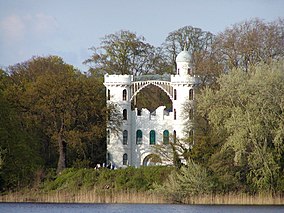Pfaueninsel
You can help expand this article with text translated from the corresponding article in German. (October 2012) Click [show] for important translation instructions.
|
| Pfaueninsel | |
|---|---|
 View of the Castle from the Havel. | |
| Location | Berlin |
| Coordinates | 52°26′4″N 13°7′51″E / 52.43444°N 13.13083°E |
| Area | 67 ha (170 acres) |
| Established | originally in 1924 |
| Governing body | Stiftung Preußische Schlösser und Gärten Berlin-Brandenburg (SPSG) |
| World Heritage site | Palaces and Parks of Potsdam and Berlin |
| www | |
Pfaueninsel (
Geography
Pfaueninsel is an island of 67 hectares (170 acres) in the river Havel, situated between Kladow to the west and Wannsee to the east and downriver from the Großer Wannsee, in Berlin, Germany. Further downstream is the Jungfernsee. The island is mostly woodland with some open areas, including lawns and fields. The total size of the protected area, including some water-covered areas, is 98 hectares (240 acres).
History
In the late 17th century the island was called Kaninchenwerder ("Rabbit Island") after a rabbit breeding station set up by
The island remained unused for about 100 years until, in 1793, the

Frederick William's successor,
The Palmenhaus ("House of Palms") was erected in 1831, based on a design by Schinkel. It housed exotic plants like tobacco, canna lilies, mangold, bananas, artichokes and rhubarb and was praised by explorer Alexander von Humboldt.[3] It caught fire for unknown reasons in the night of 19/20 May 1880 and burnt to the ground.[3] It was suggested that the fire was due to a stray spark from the chimney, as the Palmenhaus had been built out of wood. It was not rebuilt, but stone columns still trace the outline of the building.
On 15 August 1936, the German government celebrated the closing of the 1936 Olympic Summer Games on the island, with fireworks and an Italian Night party involving a thousand invited guests.[3]
In the post-World War II period, the Pfaueninsel was part of West Berlin. It was situated right next to the border to East Germany. On the shore of Sacrow to the north and west were the Grenzsicherungsanlagen (fortifications of the inner German border) of the German Democratic Republic.
In the 1960s, the Pfaueninsel served as an outdoor location for a number of films of the German Edgar Wallace series.
Today
The island has largely retained its intended character as an idyll of nature: in addition to several free-ranging
Gallery
-
The so-called Kavaliershaus (house of cavaliers)
-
Memorial temple for Queen Luise of Prussia, built 1829
-
Frigate Shelter, built 1833 for the Royal Louise, a miniature frigate
-
Column fountain, created in 1824 by Martin Friedrich Rabe
-
Meierei (dairy), view from the southeast
-
Peacock on Pfaueninsel
References
- ^ a b "Pfaueninsel". Official website of Berlin (German). Retrieved 26 April 2013.
- ^ "Palaces and Parks of Potsdam and Berlin". UNESCO World Heritage Centre. United Nations Educational, Scientific, and Cultural Organization. Retrieved 12 Jun 2022.
- ^ a b c d e f g h "Pfaueninsel info flyer" (PDF). SPG. Retrieved 26 April 2013.






![Column fountain, created in 1824 by Martin Friedrich Rabe [de]](http://upload.wikimedia.org/wikipedia/commons/thumb/1/1f/Pfaueninsel_fountain.jpg/133px-Pfaueninsel_fountain.jpg)

